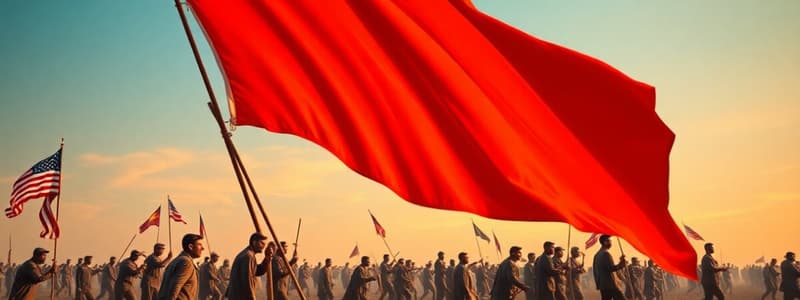Podcast
Questions and Answers
Which concept promoted the idea that certain nations were more fit to rule others?
Which concept promoted the idea that certain nations were more fit to rule others?
- Social Darwinism (correct)
- Open Door Policy
- Roosevelt Corollary
- White Man’s Burden
What was the primary purpose of the 'Committee on Public Information' during World War I?
What was the primary purpose of the 'Committee on Public Information' during World War I?
- To draft soldiers into the military via the Selective Service Act.
- To regulate food supply and consumption via the Food Administration
- To manage the production of war materials through the War Industries Board
- To disseminate pro-war propaganda and influence public opinion. (correct)
Which event directly led to the United States declaring war on Spain in 1898?
Which event directly led to the United States declaring war on Spain in 1898?
- The sinking of the USS Maine (correct)
- The signing of the Treaty of Paris (1898)
- The implementation of the Open Door Policy
- The Boxer Rebellion
What was a key impact of the Bolsheviks' rise to power in Russia?
What was a key impact of the Bolsheviks' rise to power in Russia?
Which of these was a significant consequence of the war mobilization efforts within the U.S.?
Which of these was a significant consequence of the war mobilization efforts within the U.S.?
Which of these best characterizes the 'Roosevelt Corollary'?
Which of these best characterizes the 'Roosevelt Corollary'?
What was the primary objective behind the 'Open Door Policy'?
What was the primary objective behind the 'Open Door Policy'?
How did 'Yellow Journalism' contribute to the start of the Spanish-American War?
How did 'Yellow Journalism' contribute to the start of the Spanish-American War?
Which of these best represents a defining characteristic of 'total war' during World War I?
Which of these best represents a defining characteristic of 'total war' during World War I?
What was the overall significance of 'The Great Migration’' during World War I?
What was the overall significance of 'The Great Migration’' during World War I?
What was a direct consequence of the Spanish-American War for the United States?
What was a direct consequence of the Spanish-American War for the United States?
Which of these accurately describes the 'Roosevelt Corollary'?
Which of these accurately describes the 'Roosevelt Corollary'?
Which of these was a major factor in the rise of trench warfare during World War I?
Which of these was a major factor in the rise of trench warfare during World War I?
Which of these was a key consequence of the 'Great Migration' within the United States?
Which of these was a key consequence of the 'Great Migration' within the United States?
What was the main goal of the 'Committee on Public Information' during World War I?
What was the main goal of the 'Committee on Public Information' during World War I?
What was the main cause of the Boxer Rebellion?
What was the main cause of the Boxer Rebellion?
Which of the following best describes the 'Boxers'?
Which of the following best describes the 'Boxers'?
What was the primary reason foreign powers joined together to form the Eight-Nation Alliance during the Boxer Rebellion?
What was the primary reason foreign powers joined together to form the Eight-Nation Alliance during the Boxer Rebellion?
What was a significant long-term consequence of the Boxer Rebellion?
What was a significant long-term consequence of the Boxer Rebellion?
What did the Boxer's violence primarily target during their rebellion?
What did the Boxer's violence primarily target during their rebellion?
What were the Boxers' main targets during the rebellion?
What were the Boxers' main targets during the rebellion?
What was a key characteristic of the Boxer movement that contributed to its success?
What was a key characteristic of the Boxer movement that contributed to its success?
How did foreign powers respond to the Boxer Rebellion?
How did foreign powers respond to the Boxer Rebellion?
What was a significant consequence of the Boxer Rebellion for the Qing dynasty?
What was a significant consequence of the Boxer Rebellion for the Qing dynasty?
How did the Boxer Rebellion impact China's relationship with the West?
How did the Boxer Rebellion impact China's relationship with the West?
What was the international alliance that formed to suppress the Boxer Rebellion called?
What was the international alliance that formed to suppress the Boxer Rebellion called?
What was the name of the movement that gave rise to the Boxer Rebellion?
What was the name of the movement that gave rise to the Boxer Rebellion?
Which of the following best describes the political impact?
Which of the following best describes the political impact?
What was a significant outcome of the Bolshevik revolution led by this figure?
What was a significant outcome of the Bolshevik revolution led by this figure?
What challenge arose immediately following his death?
What challenge arose immediately following his death?
Which of these best describes the long-term legacy?
Which of these best describes the long-term legacy?
What was the result of the significant power struggle after his death?
What was the result of the significant power struggle after his death?
Which of these best describes Lenin's concept of vanguardism?
Which of these best describes Lenin's concept of vanguardism?
What was the primary reason for Lenin's exile from Russia during his early political activities?
What was the primary reason for Lenin's exile from Russia during his early political activities?
Which of these best characterizes Lenin’s view of imperialism?
Which of these best characterizes Lenin’s view of imperialism?
What was a key outcome as a result of the Treaty of Brest-Litovsk, signed by Lenin's government?
What was a key outcome as a result of the Treaty of Brest-Litovsk, signed by Lenin's government?
What was the main purpose of the New Economic Policy (NEP) introduced by Lenin in the 1920s?
What was the main purpose of the New Economic Policy (NEP) introduced by Lenin in the 1920s?
What was a key purpose of the Cheka under Lenin's rule?
What was a key purpose of the Cheka under Lenin's rule?
What was a core principle that was central to Lenin’s ideology?
What was a core principle that was central to Lenin’s ideology?
Which of these was a direct consequence of War Communism, implemented during the Russian civil war?
Which of these was a direct consequence of War Communism, implemented during the Russian civil war?
Which factor can significantly influence an individual's classification regarding readiness for active duty?
Which factor can significantly influence an individual's classification regarding readiness for active duty?
What recourse is available to individuals who disagree with their Selective Service classification?
What recourse is available to individuals who disagree with their Selective Service classification?
What is the primary purpose of maintaining the Selective Service Act, despite the limited use of conscription in recent times?
What is the primary purpose of maintaining the Selective Service Act, despite the limited use of conscription in recent times?
How does the modern application of conscription differ from its historical use, particularly since the Vietnam War?
How does the modern application of conscription differ from its historical use, particularly since the Vietnam War?
What aspect of military conscription is determined by historical conflicts and their changing nature?
What aspect of military conscription is determined by historical conflicts and their changing nature?
What is the primary function of the Selective Service Act?
What is the primary function of the Selective Service Act?
Which event led to the introduction of the first Selective Service Act in the United States?
Which event led to the introduction of the first Selective Service Act in the United States?
Who is required to register with the Selective Service System in the United States?
Who is required to register with the Selective Service System in the United States?
What does a classification of '1-A' typically indicate in the Selective Service System?
What does a classification of '1-A' typically indicate in the Selective Service System?
Which factor does NOT influence an individual's classification status within the Selective Service System?
Which factor does NOT influence an individual's classification status within the Selective Service System?
What is the classification '1-O' generally associated with?
What is the classification '1-O' generally associated with?
What typically determines the call-up process within the Selective Service System?
What typically determines the call-up process within the Selective Service System?
What is a primary aim of the modifications to the Selective Service Act over time?
What is a primary aim of the modifications to the Selective Service Act over time?
Flashcards
Imperialism
Imperialism
The belief that stronger nations should dominate weaker ones, often justified by Social Darwinist ideas.
Social Darwinism
Social Darwinism
A social theory that applied Darwin's ideas of natural selection to human society, justifying imperialism by claiming some races were superior.
White Man's Burden
White Man's Burden
The idea that white nations had a responsibility to civilize and control non-white peoples, often used to justify imperialism.
Spanish-American War
Spanish-American War
Signup and view all the flashcards
Yellow Journalism
Yellow Journalism
Signup and view all the flashcards
USS Maine
USS Maine
Signup and view all the flashcards
Open Door Policy
Open Door Policy
Signup and view all the flashcards
Boxer Rebellion
Boxer Rebellion
Signup and view all the flashcards
Total War Tactics
Total War Tactics
Signup and view all the flashcards
Roosevelt Corollary
Roosevelt Corollary
Signup and view all the flashcards
What type of journalism contributed to the Spanish-American War?
What type of journalism contributed to the Spanish-American War?
Signup and view all the flashcards
Who were the Rough Riders?
Who were the Rough Riders?
Signup and view all the flashcards
What was the Open Door policy?
What was the Open Door policy?
Signup and view all the flashcards
What was the Boxer Rebellion?
What was the Boxer Rebellion?
Signup and view all the flashcards
What does total war mean?
What does total war mean?
Signup and view all the flashcards
Who were the Boxers?
Who were the Boxers?
Signup and view all the flashcards
What were spheres of influence?
What were spheres of influence?
Signup and view all the flashcards
What was the Siege of the Legation Quarter?
What was the Siege of the Legation Quarter?
Signup and view all the flashcards
Who was the Eight-Nation Alliance?
Who was the Eight-Nation Alliance?
Signup and view all the flashcards
What was the suppression of the Boxer Rebellion?
What was the suppression of the Boxer Rebellion?
Signup and view all the flashcards
What was the impact of the Boxer Rebellion?
What was the impact of the Boxer Rebellion?
Signup and view all the flashcards
What concessions were made after the Boxer Rebellion?
What concessions were made after the Boxer Rebellion?
Signup and view all the flashcards
How did the Boxer Rebellion impact Chinese nationalism?
How did the Boxer Rebellion impact Chinese nationalism?
Signup and view all the flashcards
When and where did the Boxer Rebellion take place?
When and where did the Boxer Rebellion take place?
Signup and view all the flashcards
What were the main causes of the Boxer Rebellion?
What were the main causes of the Boxer Rebellion?
Signup and view all the flashcards
Who were the Boxers, and what did they believe?
Who were the Boxers, and what did they believe?
Signup and view all the flashcards
How did the Treaty of Paris contribute to the Boxer Rebellion?
How did the Treaty of Paris contribute to the Boxer Rebellion?
Signup and view all the flashcards
How did foreign powers respond to the Boxer Rebellion?
How did foreign powers respond to the Boxer Rebellion?
Signup and view all the flashcards
What were the long-term consequences of the Boxer Rebellion?
What were the long-term consequences of the Boxer Rebellion?
Signup and view all the flashcards
What was the lasting impact of the Boxer Rebellion on China?
What was the lasting impact of the Boxer Rebellion on China?
Signup and view all the flashcards
Lenin's Global Impact
Lenin's Global Impact
Signup and view all the flashcards
The Power Vacuum after Lenin
The Power Vacuum after Lenin
Signup and view all the flashcards
Lenin's Controversial Legacy
Lenin's Controversial Legacy
Signup and view all the flashcards
Lenin and the Bolshevik Revolution
Lenin and the Bolshevik Revolution
Signup and view all the flashcards
Lenin's Lasting Influence
Lenin's Lasting Influence
Signup and view all the flashcards
Vanguardism
Vanguardism
Signup and view all the flashcards
Lenin's revolutionary strategy
Lenin's revolutionary strategy
Signup and view all the flashcards
War Communism
War Communism
Signup and view all the flashcards
Cheka
Cheka
Signup and view all the flashcards
New Economic Policy (NEP)
New Economic Policy (NEP)
Signup and view all the flashcards
Lenin's vision for socialism
Lenin's vision for socialism
Signup and view all the flashcards
Class struggle
Class struggle
Signup and view all the flashcards
What is to be Done?
What is to be Done?
Signup and view all the flashcards
What is the Selective Service Act?
What is the Selective Service Act?
Signup and view all the flashcards
Is conscription still in use?
Is conscription still in use?
Signup and view all the flashcards
Why is the Selective Service Act still important?
Why is the Selective Service Act still important?
Signup and view all the flashcards
What legal protections exist for people classified under the Selective Service Act?
What legal protections exist for people classified under the Selective Service Act?
Signup and view all the flashcards
Is drafting always the best option?
Is drafting always the best option?
Signup and view all the flashcards
Selective Service Act
Selective Service Act
Signup and view all the flashcards
Conscription
Conscription
Signup and view all the flashcards
Selective Service System (SSS) Classification
Selective Service System (SSS) Classification
Signup and view all the flashcards
1-A Classification
1-A Classification
Signup and view all the flashcards
1-O Classification
1-O Classification
Signup and view all the flashcards
Call-up Process
Call-up Process
Signup and view all the flashcards
Call to Active Duty
Call to Active Duty
Signup and view all the flashcards
Selective Service Classifications
Selective Service Classifications
Signup and view all the flashcards
Study Notes
Imperialism
- A policy of extending a country's power and influence through diplomacy or military force.
- Fueled by industrialization and competition among European nations.
- Involved colonization and control over resources and markets.
Social Darwinism
- A misapplication of Darwin's theory of evolution to society, arguing that some groups are naturally superior to others.
- Used to justify imperialism and racial hierarchy.
White Man's Burden
- The belief that white Europeans had a responsibility to uplift and civilize other, non-white cultures.
- Often used to rationalize imperialism and colonization.
Spanish-American War
- Conflict between the US and Spain in 1898.
- Resulted in US acquisition of territories like Puerto Rico, Guam, and the Philippines.
Yellow Journalism
- Sensationalized news reporting designed to attract readers.
- Played a role in escalating tensions leading up to the Spanish-American War.
USS Maine
- US battleship that exploded in Havana harbor, contributing to the conflict.
- The cause of the explosion was debated; fueled public support for war.
Rough Riders
- Volunteer cavalry regiment led by Theodore Roosevelt in the Spanish-American War.
- Became a symbol of American expansionism.
Treaty of Paris (1898)
- Treaty that officially ended the Spanish-American War.
- Established US control over various territories.
Open Door Policy
- US proposal for equal trade access in China for all nations.
- Intended to prevent the division of China into European spheres of influence.
Boxer Rebellion
- Chinese uprising against foreign influence and imperialism in China.
- Suppressed by an international military force.
Panama Canal
- Canal connecting the Atlantic and Pacific Oceans.
- A critical shipping route strategically important for trade.
Roosevelt Corollary
- Addition to the Monroe Doctrine, asserting US authority to intervene in Latin American affairs.
- Used to justify US interventions in the region.
Total War Tactics
- Military strategies that involved the mobilization of all available resources and manpower.
- Used to achieve decisive victories.
Propaganda
- Information and ideas spread to influence public opinion.
- Used to promote national goals during the war.
Trenches
- Defensive fortification used heavily in World War I.
- Created a stalemate and led to immense casualties.
Vladimir Lenin
- Russian revolutionary and founder of the Soviet Union.
- Instrumental in the Bolshevik revolution.
Soviet Union
- Former communist state established in Russia after World War I.
- A major global power during the 20th century.
Bolsheviks
- Communist party led by Vladimir Lenin.
- Responsible for the Bolshevik revolution.
Selective Service Act
- US law requiring men to register for military service.
- Led to the expansion of the armed forces.
War Industries Board
- Government agency that oversaw the production of war materials.
- Coordinated industrial production during the war.
Food Administration
- Government agency responsible for managing food supplies during the war.
- Promoted conservation and increased production.
The Great Migration
- Movement of African Americans from Southern to Northern US.
- Seeking economic opportunities and escaping racial discrimination.
Committee on Public Information
- Government agency responsible for promoting US war aims through propaganda.
- Promoted patriotism and support for the war effort.
Armistice
- Agreement to cease fighting during a war.
- Marked the end of World War I.
Studying That Suits You
Use AI to generate personalized quizzes and flashcards to suit your learning preferences.



